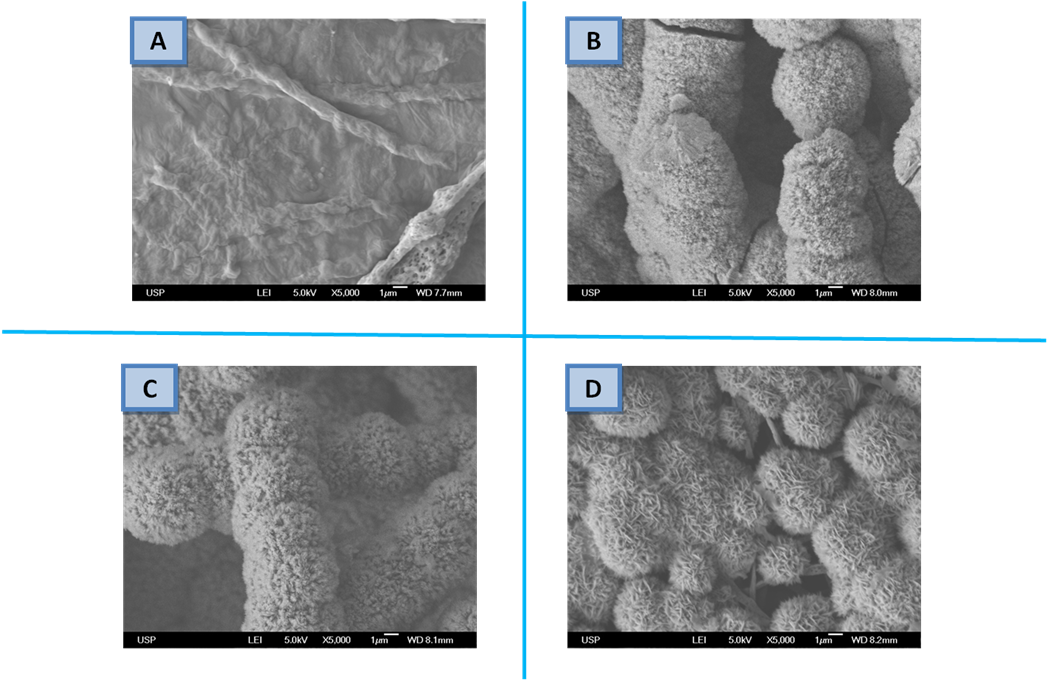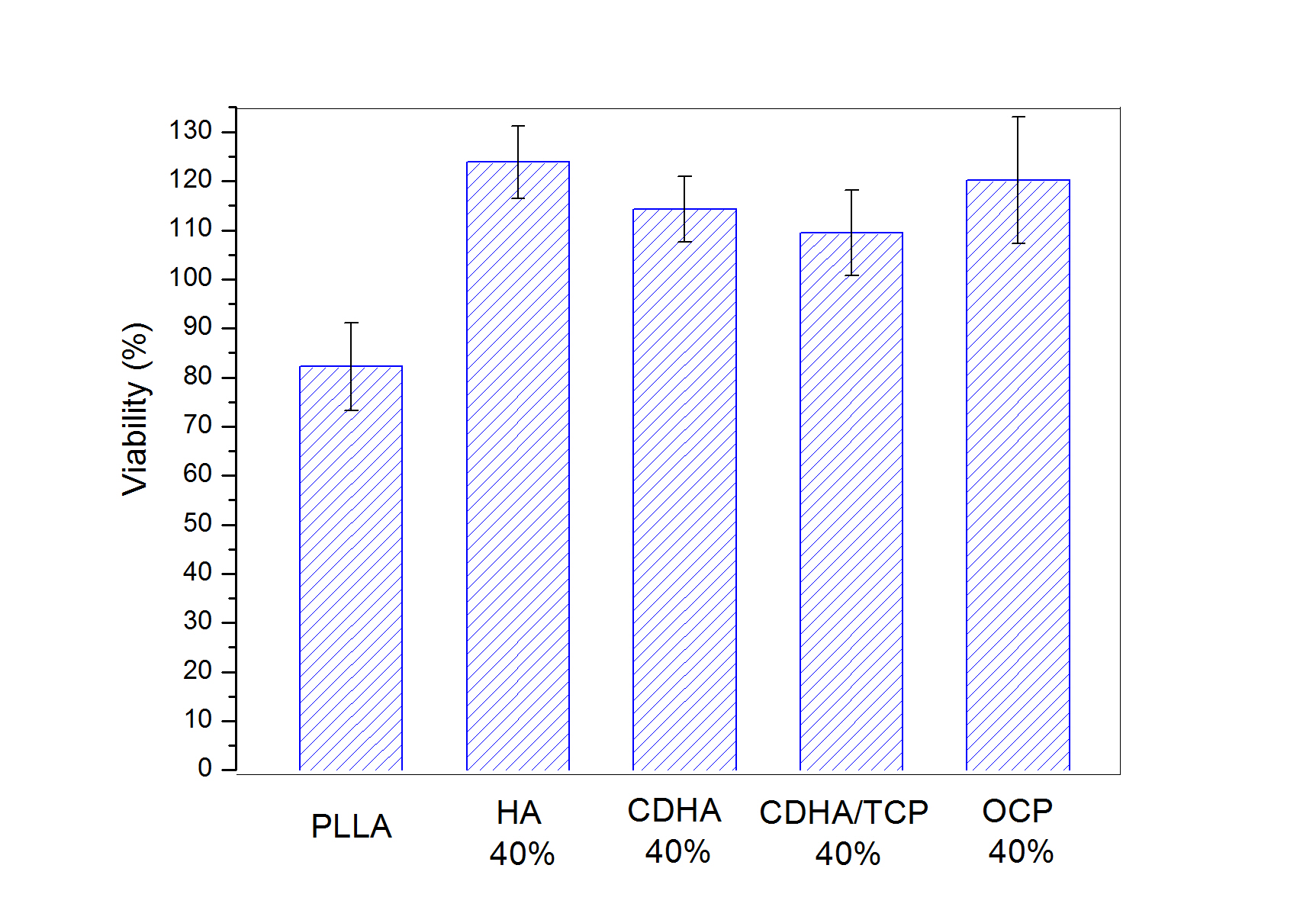Introduction: Since hydroxyapatite (HA) is the main mineral component of bones and teeth, it is widely used as biomaterial[1]. In the last decade, biocomposites of poly(L-lactide) (PLLA) and HA have attracted much attention due its ability to exhibit osteoinductive and osteoconductive properties, biodegradability and adequate mechanical strength[2]. However, its clinical use is limited owing to its slow biodegradation. Moreover, the low miscibility of HA in the polymer phase renders composites of low mineral content. Hence, other fast degradation calcium phosphates (CPs), such as calcium deficient hydroxyapatite (CDHA), β-tricalcium phosphate (β-TCP) and octacalcium phosphate (OCP) have been considered as HA substitute[3].
This work aims at the production fast degradation PLLA composites with high content of alternative CPs as mineral phases, such as CDHA, β-TCP and OCP, as well as to study their bioactivity properties.
Results: In order to improve the dispersion of the mineral phase in the polymeric matrix, lauryl chloride was used to functionalize the surface of CPs and improving the interfacial adhesion of the particles. As a result, biocomposites containing up to 40wt% of mineral phase were produced.
The bioactivity of the biocomposites was assayed in vitro using a solution of Simulated Blood Fluid (SBF)[4]. After 28 days of immersion in SBF, the formation of an amorphous calcium phosphate layer was observed on the surface of the substrate PLLA/HA; while for the biocomposites containing CDHA or CDHA/ β-TCP (7: 3) the minerals were composed of flake crystals. Increase of bone-like minerals was observed on surface of the substrate PLLA/OCP, these findings indicate that the deposited CP layer coating the surface of electrospun fibers containing OCP was in a more advanced stage of nucleation.

Figure 1: SEM images of electrospun PLLA/apatites-laurate 40 wt% after incubation in SBF for 28 days: (a) HA; (b) CDHA; (c) CDHA/TCP (7:3); (d) OCP.
The cell viability on all the samples was measured by MTT assay. While pure PLLA presented cell viability around 80%, as compared to control (PS plate) biocomposites containing 40% of funcionalized apatite showed over 100% of cell viability. These results show that these materials are not only atoxic but can help cell proliferation.

Figure 2:Viability of NIH/3T3 fibroblasts on PLLA and PLLA/apatites-laurate 40%wt nanofibrous scaffolds.
The different biocomposites were tested for adhesion and proliferation assays of NIH/3T3 fibroblasts using MTT assay. The biocomposites showed similar increase in cell proliferation, but after 15 days they promoted higher cell proliferation compared to pure PLLA electrospun fibers.

Figure 3: Proliferation of NIH/3T3 fibroblasts on the control PLLA and PLLA/apatites-laurate 40%wt nanofibrous scaffolds as a function of culture time.
Conclusions: The bicomposites high mineral phase (up to 40%) were produced. Electrospun mat of PLLA/OCP-laurate 40 wt% presented higher bioactivity in contact with SBF than similar composites containing HAD, HAD/TCP (7:3) or HA. However all CPs biocomposites in this study provided similar increase in cell proliferation, as compared to PLLA. These new materials are proposed as fast degradation CPs biocomposites for bone and teeth applications.
FAPESP (Projeto 2011/21442-6); Conselho Nacional de Desenvolvimento Científico e Tecnológico - CNPq
References:
[1] REY, C. et al. Physico-chemical properties of nanocrystalline apatites: implications for biominerals and biomaterials. Materials Science and Engineering C, v. 27, p. 198-205, Mar. 2007.
[2] QIU, X. et al. Hydroxyapatite Surface Modified by L-Lactic Acid and Its Subsequent Grafting Polymerization of L-Lactide. Biomacromolecules, v. 6, p. 1193-1199, 2005.
[3] BEST, S. M. Bioceramics: past, present and for the future. Journal of the European Ceramic Society, n. 28, p. 1319-1327, 2008.
[4] KOKUBO, T. How useful is SBF in predicting in vivo bone bioactivity. Biomaterials, n. 27, p. 2907-2915, 2006.